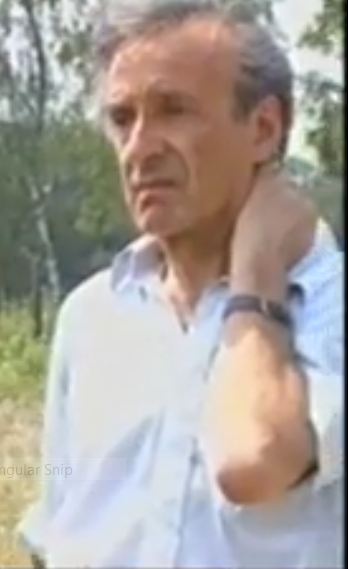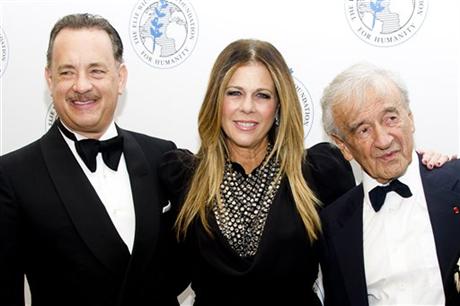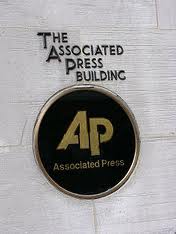Blog
New Email Address
Written on December 18, 2012 at 1:22 am, by Carolyn
This is the new address for this website, or use the contact form on the menu bar under “About.”
Message to Readers
Written on December 16, 2012 at 4:31 am, by Carolyn
To anyone who has sent an email to [email protected] in the past month or so:
I am sorry that it was not received because that email account has not been available to me for some time. I believe it was cancelled during the many changes CODOH has been undergoing recently and whatever it contained has been lost. If you want to get some information to me, just write it in a comment on the blog; I can reply to you from that without posting the comment.
Elie Wiesel Cons The World is moving and will no longer be under the sponsorship of CODOH, but it will continue as before under my direction and you will not notice any difference. I will let you know when the move is complete and there is an email account again. I could really use some contributions to help with the move and to pay the hosting costs in the future.
Many thanks to Bradley Smith for his generous support for this site since it’s beginning in 2010. He is definitely one of the good guys. Let’s all move on into a year of great accomplishment in 2013. Some exciting new breakthroughs are coming! (As soon as I get the time to write about them here.)
AP stonewalling legitimate questions about reporter seeing Elie Wiesel’s tattoo
Written on December 4, 2012 at 1:05 pm, by Carolyn
My latest phone call on the morning of Monday Dec. 3 to the Associated Press office in New York brought the following results: The answerer, upon hearing my name, immediately connected me to Corporate Communications, where I spoke to the same woman I spoke with the previous Monday, Nov. 26. I identified myself and told her I had re-sent the first email from Nov. 8 (rather than the second one from Nov. 14) as she requested but did not receive any acknowledgment of receipt from anyone. She said she forwarded it to the proper parties, but had not guaranteed there would be a reply.
In answer to my persistent questions, to which she finally gave her name as “Lauren,” though she would not give me a last name, she added the information that the email was forwarded to “the journalist and the news editor.” Lauren would not reveal the name of the news editor. She also would not answer whether AP was getting other emails and phone calls about this subject. She said to this, and so many other questions, “I can’t tell you that.” Thus the road forward on this issue is being “stonewalled” by the guilty. As we know, they are able to write and publish tons of prose about the impossible stories of the “survivors” of the “Holocaust,” but go deaf, dumb and blind when it comes to answering simple questions of fact concerning these stories. Let’s take a look at what they are actually guilty of.
 Stonewalling: To refuse to answer or cooperate (esp. in supplying information).
Stonewalling: To refuse to answer or cooperate (esp. in supplying information).
I have asked for further elucidation from reporter Verena Dobnik about her vaguely-worded but pointed reference to seeing a “death camp” tattoo on the left arm of Elie Wiesel during an interview session … that has never been seen by anyone! Yet, not a single further word has come forth from her.
What is the Associated Press
[From Wikipedia] The Associated Press is an American news agency, a cooperative owned by its contributing newspapers, radio and television stations in the United States, which both contribute stories to the AP and use material written by its staff journalists. Many newspapers and broadcasters outside the United States are AP subscribers, paying a fee to use AP material without being contributing members of the cooperative. The AP staff is represented by the Newspaper Guild union, which operates under the Communication Workers union, which operates under the AFL-CIO. The content of AP news stories relating to current political issues that impact union interests has increasingly been subject to claims of news media bias. Pictured at right: AP headquarters at 450 West 33rd Street, New York City and above right: Logo on the former AP Building in New York City
Journalistic scandals include: plagiarism, fabrication, and omission of information; activities that violate the law, or violate ethical rules; the altering or staging of an event being documented; or making substantial reporting or researching errors with the results leading to libelous or defamatory statements.
All journalistic scandals have the common factor that they call into question the integrity and truthfulness of journalism. These scandals shift public focus and scrutiny onto the media itself. Because credibility is journalism’s main currency, many news agencies and mass media outlets have strict codes of conduct and enforce them, and use several layers of editorial oversight to catch problems before stories are distributed.
However, in some cases, investigations later found that long-established journalistic checks and balances in the newsrooms failed. In some cases, senior editors fail to catch bias, libel, or fabrication inserted into a story by a reporter. In other cases, the checks and balances were omitted in the rush to get an important, ‘breaking’ news story to press (or on air). [Not the case here]
How is fabrication defined
A fabrication is a lie told when someone submits a statement as truth, without knowing for certain whether or not it actually is true [or knowing for certain it is not true]. Although the statement may be possible or plausible, it is not based on fact. Rather, it is something made up, or it is a misrepresentation of the truth. Examples of fabrication: A person giving directions to a tourist when the person doesn’t actually know the directions. Often propaganda is fabrication.
Propaganda
A form of communication that is aimed at influencing the attitude of a community toward some cause or position by presenting only one side of an argument. Propaganda is usually repeated and dispersed over a wide variety of media in order to create the chosen result in audience attitudes.
Lie
To lie is to deliver a false statement to another person(s) [by speaking or writing] which the speaking/writing person knows is not the whole truth, intentionally.
 Does Verena Dobnik’s reporting of seeing a non-existent tattoo on a famous fabricator’s arm amount to a journalism scandal?
Does Verena Dobnik’s reporting of seeing a non-existent tattoo on a famous fabricator’s arm amount to a journalism scandal?
Yes, by all criteria it does. But if no one cares, it will continue to pass unnoticed. One thing people need to keep in mind: If Verena Dobnik really had the experience of seeing Wiesel’s tattoo, as she claims, she would certainly be prepared to come forth and verify it, in the form of some kind of statement. That she doesn’t, and that her news editor and the AP are also “stonewalling” this question, tells us in no uncertain terms that she is guilty.
This website, Elie Wiesel Cons The World, charges Verena Dobnik with committing journalistic fraud, of intentionally lying in her reported interview with Mr. Wiesel about seeing his tattoo … and 2) in like manner her news editor is guilty of allowing her false claim to go past the checks that should have been performed, and 3) the AP is guilty of covering up the crime, rather than investigating it, once it was brought to their attention. 4) Lauren in Corporate Communications is guilty of “following orders” to enable the cover-up to continue. I understand she is “just doing her job” — like all those concentration camp guards that Wiesel and Dobnik like to condemn.
This calls for a lawyer, but …
This would be an excellent case if there were a lawyer that would undertake it. There are a few attorneys who will act as defense counsel in holocaust-related cases, but none who will go on the offense. The simple demand would be, “Show us the tattoo! It’s very easy to defend yourself, so why don’t you?” The silence in the face of that request tells us, by simple deduction, there is no tattoo. Thus we should keep the letters, emails ([email protected]) and phone calls (1-212-621-1500) going, and post these blogs around the Internet and to email contacts. Don’t let the AP off the hook.
Call or twitter these two people directly:
Paul Colford
Director of Media Relations
Twitter: http://twitter.com/PDColford_AP
+1 212.621.1895
Erin Madigan White
Manager of Media Relations
+1 212.621.7005
http://twitter.com/emadiganwhite
Still No Reply from AP or Their Reporter; Did Elie Show his Tattoo to Tom Hanks ?
Written on November 30, 2012 at 10:37 pm, by Carolyn
By Carolyn Yeager
 On Oct. 17 in New York, actor Tom Hanks became this year’s honoree of the Elie Wiesel Foundation for Humanity. Honored for what, you ask? Well, it’s a little vague. What is written in the news account is “Hanks’ consistent thoughtfulness and concern with his charitable endeavors.” Doesn’t specify what they are, but I looked it up separately and found Hanks is a supporter of a variety of mainly health, i.e. curing disease symptoms, and environmental causes. He is on the Board of Governers of the National Space Society, which is dedicated to the creation of a spacefaring civilization, and he supports UNICEF.
On Oct. 17 in New York, actor Tom Hanks became this year’s honoree of the Elie Wiesel Foundation for Humanity. Honored for what, you ask? Well, it’s a little vague. What is written in the news account is “Hanks’ consistent thoughtfulness and concern with his charitable endeavors.” Doesn’t specify what they are, but I looked it up separately and found Hanks is a supporter of a variety of mainly health, i.e. curing disease symptoms, and environmental causes. He is on the Board of Governers of the National Space Society, which is dedicated to the creation of a spacefaring civilization, and he supports UNICEF.
At right, Tom Hanks and his wife Rita Wilson with Wiesel at the Elie Wiesel Foundation ‘Arts for Humanity’ Gala in New York City.
Oprah Winfrey was similarly honored in 2007. That ceremony was held at the Waldorf-Astoria in New York City. The ceremony for Tom Hanks took place at the New York Public Library, the difference of location possibly having to do with pre-Madoff and post-Madoff.
However, Hanks’ award is called the Arts for Humanity award, rather than the Humanitarian Award, which doesn’t appear to be given out every year – the last one mentioned was given to Nicholas Sarkozy in 2008 when he was President of France, for his “steadfast support of Israel.” [Of course, later Sarkozy was accused of “racism” for initiating a program of deporting France’s Roma refugee population back to Romania and Bulgaria from whence they came, which must have disappointed Wiesel and his Foundation staff. ] So is Hanks’ award the same or different from the Humanitarian Award? As with everything to do with Wiesel, it can’t be pinned down.
But the question that came up in my one-track mind is: Did Elie pull back his tuxedo jacket sleeve and show the famous actor his vaunted “death camp” tattoo – as a special privilege that he reserves for certain people? Hanks didn’t mention it, so I guess not. There were probably too many people around, anyway. This tattoo-unveiling must take place when no witnesses are present to spoil what is one person’s word against everyone who was not there (i.e. everyone else)!
Only Verena Dobnik, the Associated Press reporter on the NY City beat, has made the claim of seeing the elusive symbol that represents Elie being an inmate at the Auschwitz “Death Camp.”
Verena Dobnik and AP are now hiding from this issue
A reader, Laura Bell, has written in to tell us that Elie Wiesel has stated to “her teacher” that he doesn’t show his tattoo because he doesn’t want to say “Oh, look what the Nazis did to me.” He doesn’t want to give them that satisfaction. So that is the reason eh? Well, that apparently didn’t stop him from showing it to Verena Dobnik on the occasion of her interview with him, or to someone (according to Dobnik) at Buchenwald when he was there with U.S. Pres. Barack Obama in 2009. But Verena Dobnik doesn’t want to talk about this singular honor given her past her first claim that she was given it. My emails to her via the Associated Press go unanswered and my phone calls are not returned, even though I am assured “they will get back to me.” When they find out what I want from them, they simply go into hiding mode.
Between my emails and phone calls, and those of others such as Roger and Brian, we will keep their attention anyway. Brian suggested a registered letter – that is a good idea! I suppose he found a snail mail address. I will call the New York AP office again on Monday and this time I’ll ask for the name of the person to whom I’m speaking. I hope many more of you will do the same. The phone number is 1-212-621-1500; email is [email protected].
The Associated Press has put itself into a bad position by allowing a reporter like Verena Dobnik to include unverified nonsense concerning Elie Wiesel into her news stories. But this particular bit of nonsense is very different from the usual lies about what occurred to any random self-described “holocaust survivor” 70 years ago, or even to Elie Wiesel 70 years ago. This is about right now, and what this woman “saw” on Wiesel’s arm just two months ago, and how it can be verified – because it must be verified. I suggest that Dobnik come forward and answer some questions about what she saw, and the circumstances surrounding it, because we know that Elie Wiesel won’t do so. That’s why we call Elie Wiesel a liar, and now we’re also calling Verena Dobnik a liar … and next will come the Associated Press.
AP reporter doesn’t reply to questions about seeing tattoo on Elie Wiesel’s arm
Written on November 20, 2012 at 12:11 pm, by Carolyn
By Carolyn Yeager
 Elie Wiesel photographed in his New York Office on Sept. 12, 2012, by AP photographer Bebeto Matthews. Notice how well covered his left arm is … how does he ” pull back his left jacket sleeve” to reveal his tattoo to reporter Verena Dobnik?
Elie Wiesel photographed in his New York Office on Sept. 12, 2012, by AP photographer Bebeto Matthews. Notice how well covered his left arm is … how does he ” pull back his left jacket sleeve” to reveal his tattoo to reporter Verena Dobnik?
* * *
Repeated attempts to get a response from Associated Press reporter Verena Dobnik, or any Associated Press representative, about Dobnik’s questionable Oct. 8 news story that she saw a tattoo on Elie Wiesel’s arm have failed to bring forth any response. (See prior blog post dated Nov. 7: “False report that Elie Wiesel showed reporter “his tattoo?“)
Telephone calls to the New York office of the Associated Press (212-621-1500), where Dobnik is assigned, along with two emails to the address the AP gives out for “feedback and comments” ([email protected]), which they say they welcome, have not been answered.
A pleasant young man in the Dallas office of the AP, whom I talked to some days ago, assured me that comments about stories are relayed to the reporter who wrote them. I believe that is probably true so I put the fault on Verena Dobnik. I just now called and reached another voice mail at the New York office, but this time it belongs to a man in the communications department, so perhaps I will hear back from him.
On November 14, I sent the following email to [email protected]
To: Associated Press and Verena Dobnik
Re: Verena Dobnik, New York based AP reporter and her article of Oct. 8, 2012, “Elie Wiesel survives Bernie Madoff, heart by-pass”
The Associated Press New York office is responsible for allowing a blatant example of journalistic fraud to go unchallenged. Ms. Dobnik writes in her story:
He pulls back his left jacket sleeve to reveal a Nazi death camp number tattooed on his forearm as he sits comfortably in his Manhattan office for an interview.
“Usually I don’t show it,” he says.
This either never happened or should not be included because:
-
We are not told what Dobnik actually saw. Does she know what a “Nazi death camp number” looks like? This is too vague a “description” for a professional reporter to use.
-
There is no such thing as a “Nazi death camp number” … only numbers allegedly tattooed on prisoners at Auschwitz. This reveals the propagandistic nature of the reporter’s intent. (I will not spend time belaboring the facts that there can be no purpose in tattooing prisoners in a “death camp”, and that Elie Wiesel was never scheduled for death.)
-
Elie Wiesel has NEVER shown a tattoo on his arm to any camera, even though there is a long history of questions stating doubts that he actually has one and challenging him to show it to the public. A cameraman (Bebeto Matthews) may have accompanied Ms. Dobnik on that occasion to Wiesel’s NY office and took some photos – Wiesel is seen wearing a heavy suit and long sleeved dress shirt in photos taken on Sept. 12, making it hardly possible for him to just “pull back his sleeve” to reveal a tattoo on his forearm. He would have had to unbutton his shirt cuff and roll it back, an unlikely gesture as Wiesel is not known to have done it for any other reporter.
-
Without a corroborating witness or a photo taken of Wiesel actually baring his arm with a tattoo present on it, there is no reason to believe the reporter’s casual interjection of this event.
Further, because of the controversy about Elie Wiesel’s “tattoo” it is natural to suspect this was added by Dobnik to her article to try to give some credence to Wiesel’s claim that he has a tattoo even though no one has ever seen it. The Associated Press is thus being USED by Dobnik to disseminate lies in order to further what is false propaganda about “the Holocaust” in general and Elie Wiesel in particular. The Associated Press needs to take this very seriously by questioning Verena Dobnik about this interview.
Dobnik followed up with this sentence in her article:
One of the exceptions was a 2009 visit to the Buchenwald death camp Wiesel survived, with President Barack Obama and German Chancellor Angela Merkel.
This is equally questionable. In the first place, it is very vague – it actually makes no sense, but the reader is left with the impression that Wiesel told Dobnik that he showed his tattoo to these two world leaders at that time. However, there is NO statement from Wiesel himself that he showed a tattoo to Obama and Merkel in 2009 at Buchenwald. Also none from Obama or Merkel. This absolutely smacks of fabrication on the part of the reporter to make her interview more interesting, and maybe more important and noticeable. However, NO OTHER PUBLICATIONS or writers picked up on this astounding news that Wiesel had made this gesture to two world leaders at Buchenwald! Why not? Because it is not corroborated and no doubt could not be corroborated.
Also, Dobnik is stating falsely that Buchenwald was a “death camp.” It has been admitted for many years by official Holocaust historiography that Buchenwald was not a so-called death camp, and that there were no “death camps” in Germany. According to the official version of the Holocaust, there were only five “extermination camps,” all in Poland.
Verena Dobnik is guilty of (1) interjecting false propaganda into her reports for the purpose of misinforming and inciting hatred against Germany in the minds of her readers. If she is ignorant about the facts of the Holocaust, the editors at the Associated Press should not be. But worse, she is guilty of (2) LYING about what took place during her interview with Elie Wiesel.
I am serious as a heart-attack about this blatant case of journalistic fraud carried out under the nose of the Associated Press, and approved by you. I demand that you reply to this email within a few days time and give me whatever explanation you have. If you find that my complaint has legs, you need to issue a public retraction and an apology. I intend to pursue this issue vigorously.
Very truly yours,
Carolyn Yeager



